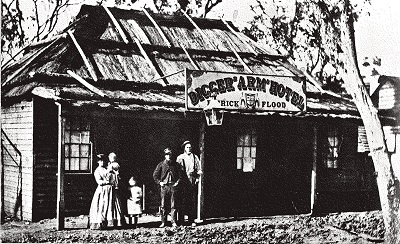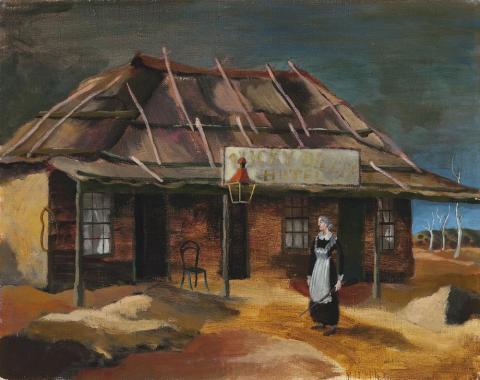LUCKY DIGGER HOTEL, HILL END, 1953
DONALD FRIEND
oil on canvas
40.5 x 51.0 cm
signed lower right (ind.): Donald Friend
Private collection, United Kingdom
Company collection, Sydney
When Donald Friend and Russell Drysdale came across the former New South Wales gold mining town during a car trip in 1947, they were both immediately enchanted by the beauty and history of the town. Donald Friend was so impressed that he and his friend Donald Murray purchased a cottage, close to the Royal Hotel, and lived there on and off between 1948 and 1958. Years later, Drysdale purchased the cottage from Donald Friend and gifted it to Murray, who remained living there until his death in 1988.
Friend’s painting, The Lucky Digger Hotel, c.1953 – 54 is a direct response to a photograph taken by Henry Beaufoy Merlin in 1872 (pictured below). At the height of Hill End’s gold rush, the town’s most celebrated prospector was Bernhardt Holtermann, who was a partner in the Star of Hope Mine on Hawkins Hill. It was there, on 19 October 1872, that they discovered the Beyers Holtermann nugget, the largest gold specimen ever found at Hill End. In 1872, Holtermann, who was somewhat of an aesthete, commissioned the photographer, Beaufoy Merlin, to record the buildings, people and goings on of the town. This resulted in a comprehensive collection of photographs which until 1951 lay undiscovered in the garden shed of Holtermann’s grandson at Chatswood in Sydney. These photographs became known as the Holtermann Collection, and their discovery caused great excitement across the country, most certainly for historians, but also amongst the residents of Hill End.
In November 1953, the Holtermann Festival was held at Hill End to mark the eightieth anniversary of the creation of these photographs. Central to the Festival was an exhibition of the actual photographs, and Donald Friend’s excitement at seeing the collection is evident in his diary note of 10 November 1953: The famous Holtermann photographs have arrived, including a panorama showing this cottage of ours, looking ridiculously bare when one compares the bowers of flowers and trees and shrubs that embellish it now, and the whole town in the days of its rackety overpopulated heyday – 1872 – with suburbs of bark huts and alleys of shanties and miners’ tents. 1
While Friend’s drawings display a languid sensuality that allows the artist to flaunt his ravishing draughtsmanship, his paintings exhibit a more direct, matter-of-fact quality. They often appear as historical narratives littered with mischievous anecdotes and witticisms. The Holtermann Collection provided Friend with rich insight and material. One photograph the artist chose to work from shows the ‘Digger’s Arms Hotel’, which was one of many pubs in Hill End at the peak of the gold rush. In the photograph we see the publican Patrick Flood and his family on the verandah of the pub. However, in Friend’s painting he re-names the pub the more optimistic ‘Lucky Digger Hotel’, and in a theatrical twist Friend replaces the publican and his family with a gun-toting single female, possibly based on a character from Hill End folklore. Apart from this alteration, Friend’s painting is true to the image and in particular the bark roofed building, which reflects the artist’s interest in the actual history of the town, and perhaps its building techniques. As Friend’s diaries attest, both he and Donald Murray were very much DIY renovators themselves.
Russell Drysdale and Donald Friend’s paintings of Hill End are among their most important works with many held in public institutions. When Russell Drysdale and Donald Friend discovered Hill End in 1947, it was the beginning of an artistic legacy that continues today. Michael Johnson, John Firth-Smith and the late Brett Whiteley all fell under the spell of Hill End’s charm and romance. It continues to be almost a rite of passage for young Sydney painters to make the trek to Hill End to absorb the atmosphere, and wander the village matching the existing buildings with the many famous paintings based on the town before retiring to the Royal Hotel for a glass or two of Australia’s golden art history.
1. Hetherington, P., The Diaries of Donald Friend, vol. 3, National Library of Australia, Canberra, 2005, p. 241 – 242
HENRY MULHOLLAND
Lucky Digger photograph_Pcmyk.jpg

